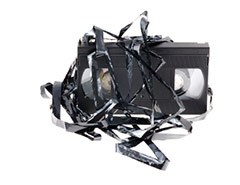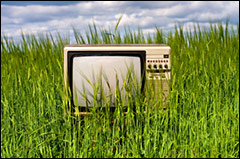
When it comes to watching television, it’s practically your environmental duty to gaze at Adrian Grenier on Planet Green and cheer on Major League Baseball’s efforts to become more sustainable. (That’s what we tell ourselves, anyway.)
But did you know the chemicals in that idiot box could be rotting your brain even more than the trashy reality shows? The lead in TVs and even dust resting on top have come under scrutiny for posing health risks, and nitrogen trifluoride (a chemical used in manufacturing flat-screen TVs) has been criticized as a contributor to global warming. Environmentally speaking, the boob tube is one Ugly Betty. But energy-saving sets could make it your living room’s Next Top Model of efficiency.
Want to give your couch-potato habit the green-screen treatment? Here’s how to start.
Level One: The Baby Step
Strip it all. Channel Buffy and vanquish your home’s “energy vampires” — appliances that suck electricity while they’re turned off but plugged in — by using power strips (way less smelly than garlic). One strip is so smart that when a “control” appliance like a TV is turned off, it stops powering related appliances like a DVD player or speakers. And don’t worry about constantly reprogramming the VCR: Said strip also has designated outlets for appliances that need uninterrupted power. Stripping has many bonuses (wink, wink), one of which is saving bank on electricity bills. The Department of Energy says [PDF] some three-quarters of the electricity used to power home electronics is consumed while the products are turned off, and one estimate puts the annual cost of powering Americans’ turned-off appliances at $1 billion. This worksheet [PDF], which also has instructions for a kid-friendly “energy vampire hunt,” will help you calculate how much moolah you could save.

Level Two: The Next Steps
Green your collection. Trade the dusty vids and albums on your shelves for different ones for free on sites like Swaptree and Neighborrow, or recycle unwanted DVDs and VHS tapes through Greendisk. Reduce your consumption by using Netflix, an on-demand service, or your local library. Want to watch green? Check out Grist’s list of 15 green movies for ideas. And if purchase you must, buy used through a service like Peerflix — or consider getting socially conscious films by mail each month via Ironweed.
Kill a watt. Assess how efficient your current appliances are, and if they’re energy-sucky, consider replacing them with versions that have been certified by Energy Star. The government-backed program claims that if every U.S. household used Energy Star TVs, VCRs, and DVD players, the environmental result would be the equivalent of taking 2 million cars off the road — and your household could cut the electricity bills by 30 percent annually [PDF]. If you’ve weathered the debate about the chemical NF3 in flat-screen TVs, withstood anti-consumption rants from friends, and found yourself still on the market, the Philips Eco TV is a drool-worthy (albeit pricey) option.
Put the ‘fun’ in furniture. If you’re buying furniture for your entertainment center, go with secondhand pieces if possible, and if not, beware of creepy materials and sketchy labor conditions. Avoid volatile organic compounds like flame retardants on anything squishy and keep the “No vinyl; that’s final” mantra in mind. With side or coffee tables, make sure the wood is good by ensuring it’s certified as sustainable, and check out this list of green furniture tips for the DL on bamboo, reclaimed materials, and recycled metal. Though there is no fair-trade certification for furniture yet, the U.K.’s Fair Trade Furniture Company has cozy, ethically made chairs, and Ten Thousand Villages has a modest selection, too.
Unplug yourself. Mom was right to tell you to turn it off and go play outside. Declare one TV-free day a week to reduce energy use and reinvigorate your life.

Level Three: The Big Step
Ditch it. Wash that tangle of wires right outta your hair by getting rid of the whole thing! Make sure your old set doesn’t end up as e-waste, though — the TakeBackMyTV campaign says only 12 percent of discarded electronic equipment is recycled. Use this map to find an electronics recycler in your state, or plug your zip code into this handy site. Sony and LG now take back old TVs for recycling; tell other manufacturers they should too. You can also donate your old equipment to a worthy cause, thrift store, or friend. Sites like Gazelle will even give you dough for recycling some electronics like video-game consoles. Find entertainment in people, your community, and nature, and enjoy having your life back.
Resources
Electronics
Energy Star
Earth 911 on electronics
The huge energy use of TVs
Advice from Umbra in the Grist archives
On the Energy Star label
On replacing appliances
On power strips
On recycling VHS tapes
Movies and TV shows
15 green movies
An interview with the co-founder of trading site Swaptree
Swaptree
Neighborrow
Peerflix
TV recycling
U.S. EPA
TakeBackMyTV
Find a recycler by state
Find a recycler by zip code


